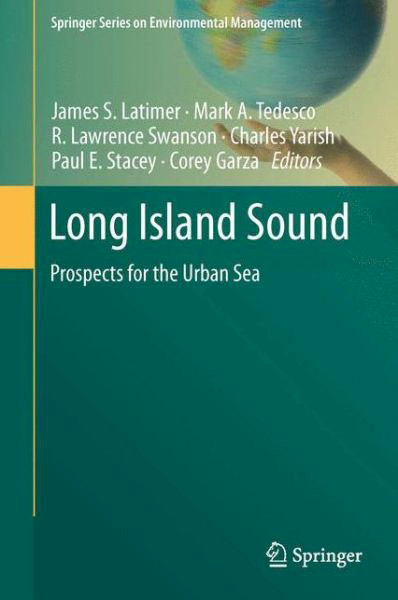Long Island Sound: Prospects for the Urban Sea book synopsis
Bill Dennison ·In early 2014, a 558 pp. book “Long Island Sound: Prospects for the Urban Sea” was published. The co-editors JS Latimer, MA Tedesco, RL Swanson, C Yarish, PE Stacey and C Carza were able to get 57 contributors to produce this comprehensive summary of the state of science in Long Island Sound. Springer lists the book for $279 and the eBook for $219, which is a steep price. Mark Tedesco joked that if you account for the length of time that it takes to read this rather dense book, that the price per reading time is not too bad.
There are 7 chapters in the book covering 1) socioeconomics, 2) geology, 3) physical oceanography, 4) geochemistry, 5) contaminants, 6) biota and 7) management. The first 6 chapters were written quite independently, and Chapter 7 summarizes the first 6 chapters and offers a historical perspective and discusses the future of Long Island Sound.
I found the historical perspective of Long Island Sound quite interesting. Long Island Sound was formed by recessional glacial moraines that constitute Long Island. It was first settled by native Americans some 12,000 years ago, and permanent settlements are evident from about 2 or 3 thousand years ago. Native Americans harvested shellfish and anadromous fishes like eels, lampreys, herring and salmon. European discovery by Adriaen Block, a Dutch merchant was followed by west to east development of Long Island and south to north development of Connecticut (up the river valleys).
The Sound was an important nautical highway, particularly since the entrance into New York Harbor through the Verrazano Narrows was limited by shallow sand bars (7.3 m controlling depth) until 1885 when steam powered dredges were able to maintain deeper channels. The alternative route into and out of New Harbor was through Long Island Sound and down through Hell Gate, which separates Long Island from Manhattan Island. There were some treacherous rocks in the fast moving tidal currents of Hell Gate that were removed with massive explosives in 1876 to facilitate shipping.
In the 1800s, steamships plied waters of Long Island Sound, and ferries were instituted in the 1920s. Robert Moses, the “master builder” of New York and its suburbs, proposed a bridge over Long Island Sound to complement the two existing bridges at the western end of Long Island Sound, but this never eventuated. Daniel Webster called Long Island Sound “America’s Mediterranean” and Lee Koppelman coined the term “The Urban Sea”, which this book uses in its subtitle.

Long Island Sound produced vast amounts of menhaden that were processed in Connecticut and used in Long Island as fertilizer to take advantage of the sandy soils and extended maritime growing season. Manufacturing along the Sound produced hats (e.g., Danbury, CT) and ships (e.g., Port Jefferson, NY), supported whaling (e.g., New London) and beach seining (pre-1860s) and purse seining (post-1860s).
The productive fisheries of Long Island Sound, including shellfish (e.g., oysters, scallops, lobsters and clams) and finfish (e.g., menhaden, salmon, shad, bluefish, striped bass) have long supported New York City and the nearby cities.
Chapter 1 provides a socioeconomic perspective. Some of the amazing facts included the estimate of 750,000 recreational fishers using some 200,000 boats and generating $22,000,000 per year. The formation of the 1936 Tri-State Environmental Commission (now the Interstate Environmental Commission) and the Long Island Sound Study in 1994 were responses to the need to curtail pollutant inputs.
Chapter 2 provides a geological overview which emphasizes the two distinct coastlines; Connecticut with its pocket beaches and crystalline rock headlands and Long Island with its groundwater dominated flow sandy shoreline. The sloping crystalline bedrock from the Connecticut shoreline and the coastal plain sandy strata on the Long Island side of the Sound form the Long Island Sound basin.
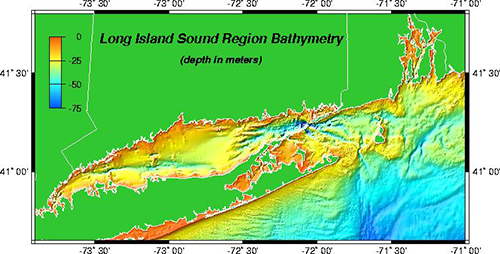
Chapter 3 covers the complex physics of this estuary. Long Island Sound is an unusual estuary in that the freshwater sources are largely through discharge from the Connecticut River near the mouth of the Sound, rather than typical estuaries with the freshwater flows concentrated at the head of the estuary. Long Island Sound length is roughly the wavelength of the semi diurnal tidal wave, which contributes to a strong east-west gradient in tidal range; from 0.7 m in eastern Long Island Sound to 2.2 m in western Long Island Sound.
There are three weak gyres of residual flows in the Long Island Sound basin, with the western and eastern basin circulation counterclockwise and the central basin circulation clockwise. Sea level is affected by winds, and a meter of additional sea level will set up in the eastern sound (westerly breezes) and western sound (easterly breezes). One of the non-intuitive features of Long Island Sound is the decrease in western sound bottom water (‘cool pool’) that has been observed between 1940 and 2010. The authors attribute this declining temperature to stronger vertical stratification occurring due to changes in the mean wind direction.
Chapter 4 covers the geochemistry of the Long Island Sound. The isotopic dating of sediments indicates sedimentation rates ranging from 0.4 - 1.7 cm/yr. Phytoplankton blooms create an excess of total organic carbon loading to bottom water, leading to hypoxia and pulses of sedimentation. There were a plethora of geochemistry studies of Long Island Sound sediments in the 1980-1990s, but less recently.
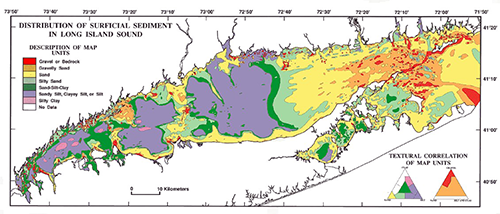
Chapter 5 covers the contaminants that find their way into Long Island Sound. The historical ‘brass valley’ in Connecticut has led to accumulations of mercury (hat manufacturing) and silver (weapons manufacturing). All of the sediment metal concentration maps display a strong longitudinal gradient of high concentrations in the western Sound and low concentrations in the eastern Sound. In addition, this west to east pattern is found in other contaminants, including Polycyclic Aromatic Hydrocarbons (PAHs from fossil fuel burning), Polychlorinated Biphenyls (PCBs), and Clostridium (sewage bacteria).
Chapter 6 is the longest and most comprehensive chapter in the book. This chapter, led by Glenn Lopez with 32 co-authors, is almost a book on its own.
The salt marshes of Long Island Sound are concentrated on the Connecticut coast, with intertidal mud flats concentrated on the Long Island coast. Some of the Connecticut marshes are Ramsar listed. Marsh ditching for mosquito control was common, and now restoration activities are practiced in the marshes. An invasive strain of Phragmites affects Long Island Sound marshes. There was a large marsh loss noted in 1999, and the western marshes appear to be ‘drowning’ due to relative sea level rise.
Seagrasses in eastern Long Island Sound remain, and there is evidence of historical seagrass populations in western Long Island Sound. The habitat requirements for the major seagrass of Long Island Sound, Zostera marina (eelgrass), differ from those established in Chesapeake Bay. Long Island Sound eelgrass habitat requirements are the following: Chlorophyll a concentrations <5 ug/L, Dissolved inorganic nitrogen concentrations <0.03 mg/L, Dissolved inorganic phosphorus concentations <0.02 mg/L, Total suspended solids concentrations <30 mg/L. There is an active seagrass transplanting program underway.
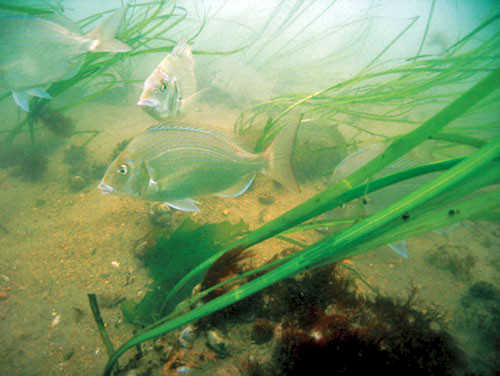
The seaweeds of Long Island Sound include both warm and cold species. The benthic seaweed communities have higher species diversity in eastern Long Island Sound. There has been some recent seafloor mapping and documentation of the impact of 40 years of dredging and sediment dumping in central Long Island Sound.
The fishes of Long Island Sound include over 100 species. The decline of oysters began in the late 1700s, and the wild fisheries are largely been replaced by aquaculture of clams and oysters which produce between $26-49 million dollars annually. There was a 1997-1998 disease die-off of aquaculture shellfish. The lobster fishery was concentrated in western Long Island Sound, but there was a substantial die-off in 1999, due to warm temperatures and hypoxic bottom waters. The only remaining lobster fishery is in the deeper portions of central Long Island Sound and the Race at the eastern end of Long Island Sound. The finfish trawl samples indicate a declining commercial fishery. However, there is a very active recreational fishery for bluefish, striped bass, scup and flounder, worth approximately $1.2 billon dollars annually.
Sea turtles occasionally end up in Long Island Sound, and ‘cold stunning’ has been observed when water temperatures go too low for these cold-blooded animals. There are many bird species that utilize Long Island Sound. Two species appear to be increasing: oystercatchers and skimmers. Marine mammals are found in the Sound, including dolphins and harbor seals. Gray seals have observed since 2001 as well.
There is a rich scientific history in benthic geochemistry and biology in Long Island Sound. The hypoxia on Long Island Sound bottom waters is well documented, initiating near the Throgs Neck bridge in western Long Island Sound and expanding eastward. Hypoxic events last between 33 and 82 days/year. There have been observable reductions in nitrogen loadings, but no improvements in hypoxia have occurred.
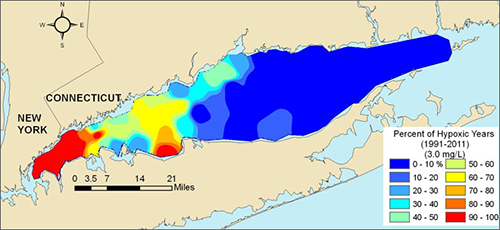
Chapter 7 focuses on the management of Long Island Sound. It chronicles the transition from a ‘natural paradise of plenty’ to natural resource extraction, followed by agricultural and industrial development, suburbanization and finally the current era of regulation and restoration activities. A scientific history is provided, with a key role of the Bingham Oceanographic Laboratory (1930-1966), part of Yale University, with leading scientists like Gordon Riley studying Long Island Sound. The issue of hypoxia was identified as the number one issue for Long Island Sound. The Total Maximum Daily Load target is for a 58.5% reduction of nitrogen loading to Long Island Sound.
There are six wastewater treatment plants along the East River, and 79 throughout the Connecticut watershed. The population pressure continues to grow, with a 3.5% increase between 2000-2010. Twenty million people live around Long Island Sound. In spite of this population pressure, the management goal is to restore Long Island Sound. Glenn Lopez characterized Long Island Sound as “the first 21st century estuary”. The book concludes with a vision that the “Urban Sea” will retain its eminence as a beautiful, productive, enjoyable place to live and work in the 21st century.
About the author
Bill Dennison

Dr. Bill Dennison is a Professor of Marine Science and Vice President for Science Application at the University of Maryland Center for Environmental Science.
